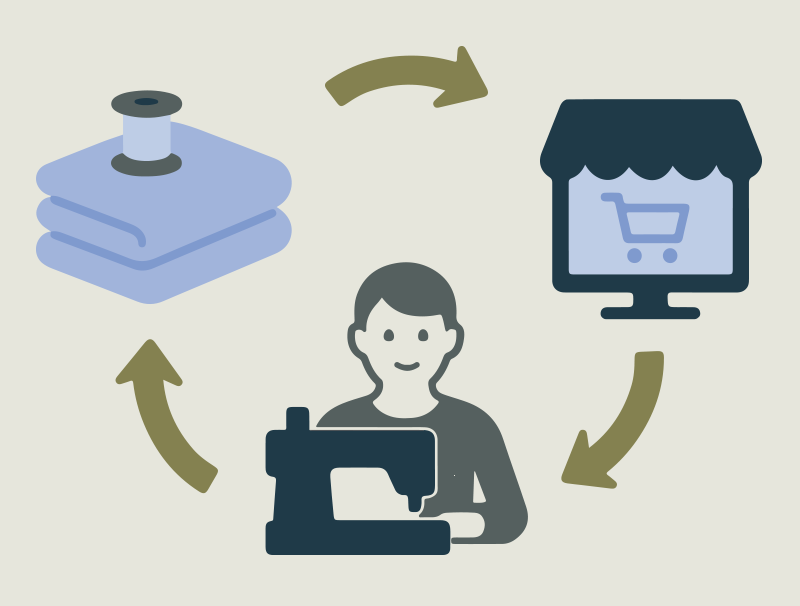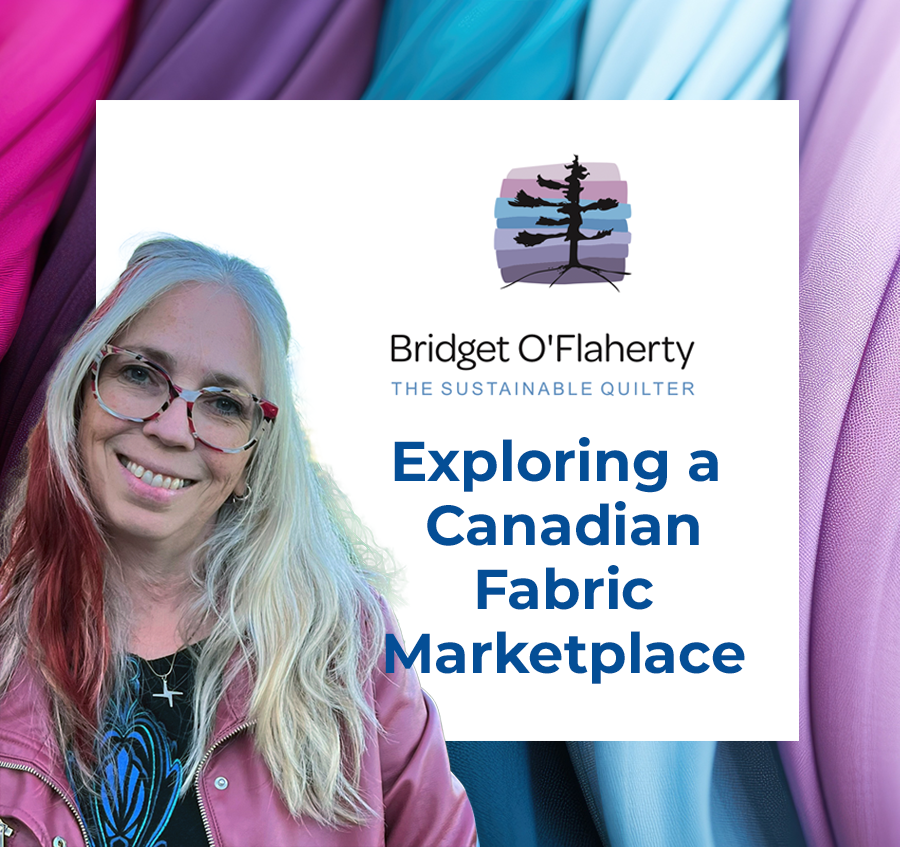In the ninth installment of Sustainable Quilting for Canadian Quilter magazine, Bridget explores what a fabric sharing/repurposing enterprise might look like. If you are interested in supporting this idea, see the Call to Action below and contact Bridget.
STITCHING SUSTAINABILITY INTO QUILTING
Exploring a Canadian Fabric Marketplace
As quilters, we face an ongoing challenge: how do we responsibly source our materials and supplies without contributing to waste? From unreliable fabric exchanges on social media to the high cost of shipping across Canada, many of us are left searching for better alternatives.
The idea for a Canadian second-hand fabric marketplace emerged from conversations with quilters seeking a sustainable way to buy, sell, and exchange materials. This article is more of a request for input. I am opening up a dialogue to discuss our needs and wants, barriers and opportunities together.
Why a Canadian Fabric Marketplace Could Matter
Unlike the U.S., where shipping is often faster and cheaper, Canada’s vast geography presents unique challenges. American platforms like Feel Good Fibers have successfully provided a space for quilters to circulate second-hand fabric, proving that this kind of marketplace can work.
However, Canadians have been excluded from this platform due to the cross-border import, export, and tax complications, as well as increased shipping costs. Yet, a whopping 68.6% of Canadian quilters surveyed expressed definite interest in using an online marketplace for exchanging and de-stashing second-hand fabric and craft supplies.
For many quilters, sourcing fabric from other parts of the country—or even within their own provinces—can be cost-prohibitive. Nearly 70% of Canadian quilters expressed frustration with high shipping costs when buying fabric online from domestic sources.
What if there was a way to foster local connections and reduce shipping concerns, support Canadian businesses, ensure reliable transactions, and focus on sustainability?
Could there be a better way to navigate the complexities of shipping and trust? Many quilters in Canada currently rely on social media groups to buy and sell fabric, but these spaces can be unpredictable and there’s no built-in way to ensure trust between buyers and sellers.
At the same time, there’s a growing desire for alternatives that offer a more intentional, community-driven space for connecting, exchanging, and learning. But what exactly could this alternative look like?
The Urgency of Now: A Circular Economy for Quilters
Textile waste isn’t just an environmental issue—it’s a legacy issue. Did you know that textiles account for up to 10% of landfill waste in Canada? The fabric, notions, and supplies we accumulate today shouldn’t become a burden for the next generation.
Instead, we can create a space where resources are intentionally shared, repurposed, and passed along responsibly.
A circular economy in quilting means keeping high-quality fabric and supplies in circulation, ensuring they remain useful for years to come. 94.7% of respondents to the recent survey indicated that they would be interested in buying or selling second-hand quilting cotton on such a platform.
This strong interest underscores the opportunity to build a system where fabric is repurposed, reused, and shared among quilters who want it most.
Sewing Opportunities in our Backyard: Benefits for the Canadian Economy
Moreover, by supporting a Canadian enterprise, we’re also supporting other Canadians by keeping money in our local economy. But what if we could measure the positive impact of this marketplace beyond dollars and cents?
By tracking the amount of fabric diverted from landfills through our platform, we can tangibly demonstrate the environmental benefits of circularity. This not only strengthens our quilting community, but also contributes to economic sustainability by fostering local business and environmentally responsible practices.
Young Generations and the Rise of Upcycling and Second-Hand Shopping
The younger generations, particularly Millennials and Generation Z, have increasingly embraced values rooted in sustainability, ethical consumerism, and reducing environmental impact. This mindset is reflected in their preferences for second-hand, upcycling, and reuse—values that directly intersect with the world of quilting.

Upcycling is Cool
Today, upcycling is not just a buzzword; it’s a lifestyle choice for many young people. According to a 2023 Statista report, 72% of Millennials and 66% of Gen Z prefer buying second-hand or pre-loved items as a conscious choice for sustainability, with over 60% of both groups acknowledging that they are actively engaged in reducing waste by upcycling or repurposing materials.
In the quilting world, these numbers align perfectly. Many young quilters, even those with limited resources, are seeking ways to incorporate sustainability into their crafting. Instead of purchasing new, they are looking for fabrics, scraps, or even unwanted textiles to upcycle into their quilts.
This is not just a cost-saving measure—it’s a philosophical choice, one rooted in the desire to give new life to old items and avoid contributing to the ever-growing textile waste crisis.
Whether it’s finding vintage quilting cotton, repurposing old linens, or buying fabric from community groups, young quilters are joining the movement to reuse and recycle materials.
Empowering Young Quilters Through Upcycling
Young quilters aren’t just looking for cheap fabric; they’re looking for materials with a story—fabrics that have already been through one life cycle and are ready for a new one. Upcycled materials allow them to be part of the solution, not just the problem.
There is an opportunity to connect the typical quilter in Canada—women over 65 with large stashes—to these young DIYers.
Existing Community Initiatives: Building on a Strong Foundation
Quilting has deep roots in Canadian culture, symbolizing resilience, creativity, and community. We could build on this foundation to support swaps, trunk sales, meetups, and community-led markets—places where quilters can connect, exchange resources, and learn about sustainable textile practices. A national marketplace could complement and collaborate with these efforts already in place.
Several Canadian organizations are already making significant strides in fabric reuse and sustainable quilting:
- Quilts for Survivors & Victoria’s Quilts Canada: Turning donated fabric into quilts for those in need.
- UJAMAA GRANDMAS: Supporting the Grandmothers to Grandmothers campaign by selling fabric and craft materials.
- The Green Thimble (Victoria, BC): A fabric and sewing supply consignment shop dedicated to reducing textile waste.
- Blenderz Garment Recyclers (Edmonton, AB): A circular textile hub repurposing fabric and offering resale options.
- EcoEquitable (Ottawa, ON): A social enterprise that empowers women while promoting fabric reuse.
- Our Social Fabric (Vancouver, BC): A non-profit keeping high-quality materials in circulation by selling donated deadstock fabric and fibre arts supplies.
By collaborating with these groups, a marketplace could serve as a hub for connecting quilters with existing resources while expanding access to sustainable quilting materials nationwide.
Overcoming Key Challenges: Shipping, Trust, and Accessibility
Through our survey and discussions, several concerns around an online marketplace emerged:
Shipping Costs: Can we build regional connections to reduce long-distance shipping? Would local pickup points or guild partnerships help? Shipping costs were frequently cited as a major challenge, with many respondents highlighting the need for more affordable and reliable shipping options.
Trust in Sellers: Unlike unregulated Facebook groups, this marketplace could incorporate seller verification, clear descriptions, and buyer protections. As one quilter noted: “Pictures don’t always show enough features.” Our platform could address this by requiring sellers to provide detailed descriptions, high-quality images, and even optional video walk-throughs of their fabrics.
Quality and Cleanliness: Several respondents expressed concern about the quality, cleanliness, and potential odours of second-hand fabrics. The marketplace could implement a rating system and provide guidelines for accurate product descriptions to address these concerns.
Going Beyond De-Stash Groups: How can we ensure this platform offers more value—such as educational resources, community support, and sustainable textile advocacy?
What Could This Marketplace Look Like?
There are many ways this could take shape:
- A simple buy-and-sell platform? A straightforward marketplace where users list and purchase second-hand fabric.
- A trade economy based on points? Allowing members to exchange fabric and supplies without direct monetary transactions, fostering a community-centric approach.
- A social enterprise? Generating funds to support textile sustainability projects.
- A co-op model? A member-owned marketplace where quilters collectively shape policies, share resources, and benefit from pooled profits.
- A resource hub? Providing education on local sustainability initiatives.
- An exchange system? Using loyalty points or charitable contributions in addition to selling options.
- A network of regional hubs? Reducing shipping barriers by enabling in-person transactions.
Each of these approaches has benefits and challenges. How do you see yourself interacting with a second-hand quilting marketplace?
Seeking Advisors: Help Shape the Future
This marketplace is still an idea in development, and your input is crucial. Would you be interested in shaping this project? We are looking for quilters, textile artists, sustainability advocates, and business-minded individuals to join an advisory board to explore funding opportunities (including grants) and determine the best structure for this initiative.
A Call to Action: Join the Conversation
We want to hear from you! How do you see this marketplace working for you? What challenges should we address? What features would be most useful? Your insights will help shape the next steps. Go to bridgetoflaherty.com/marketplace to learn more.
 Bridget O’Flaherty is a Canadian free-motion embroiderer, quilter and textile artist, teacher, speaker and podcaster with a decade of experience in the sustainable building industry. Known as The Sustainable Quilter, she shares her passion for the natural environment in her art and online community.
Bridget O’Flaherty is a Canadian free-motion embroiderer, quilter and textile artist, teacher, speaker and podcaster with a decade of experience in the sustainable building industry. Known as The Sustainable Quilter, she shares her passion for the natural environment in her art and online community.
bridgetoflaherty.com
bridgetoflaherty.com/threads-of-sustainability-podcast/
@bridgetoflahertytextiles


